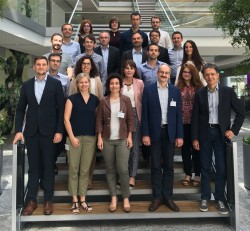ROMEO sets the first steps towards innovative technologies to reduce O&M costs in offshore wind
One year after ROMEO’s kick off meeting, consortium partners met on the 5th and 6th of June in Copenhagen to celebrate their General Assembly. The main objective of this internal meeting was to perform a follow-up of the project and define the next steps in order to achieve success. All consortium partners have had the chance to show the project's progress and coordinate the next steps. The meeting has been hosted by Ramboll, in Copenhagen, marking a milestone in the development of ROMEO. This project is awarded by the European Commission with a Horizon 2020 Programme grant of €10 million and a total budget of approximately €16 million running for 5 years. The General Assembly meeting is a useful opportunity to develop constructive discussions about the different areas, and to move forward towards the final objective of the project: reduce the cost of offshore wind energy and boost the renewables industry. ROMEO aims to reduce the operation and maintenance (O&M) costs of offshore wind farms through the use of advanced monitoring strategies and tools, as well as to analyse the performance of the wind farm turbines in real time. To reach this achievement ROMEO develops a cloud-based platform which will accommodate models for diagnosing and predicting faults in wind turbine components. This platform will promote better understanding of the performance of the main wind turbine components in operation, aiming to extend their lifetime and to reduce O&M costs. Project requirements defined as a solid roadmap During the first year of ROMEO, project requirements have been defined as a solid roadmap to ensure that it is developed under a methodical approach towards a condition monitoring strategy for relevant critical components. Additionally, a common framework for structuring the project and the designations to be used has been established. This is particularly important for the three wind farm pilot scenarios in terms of turbine and structure components. As one of the first steps of the ROMEO project, FMECA workshops were organised. The objective of the Failure Mode Effect Analysis Workshops was to define components/failures to be analysed in the project, both for the wind turbine and the substructure. The failure modes that apply for predictive maintenance were identified according to their criticality. The output of this set of workshops laid the basis for validation of the technical work packages included in the project. Backbone of O&M Information Management Platform starts to be developed Another key milestone that will allow setting the solid structure of the project is the O&M information management system, already configured. The platform will be able to suit processing and interrogation of all incoming data streams, from a variety of sources from both human and machine interfaces. At the same time, ROMEO has started the development of physical models for a running design, and specification of support structure monitoring problems for wind warms is already done. During the KoM, the partners also discussed the progress of the three pilot tests that will be developed in the framework of ROMEO and will allow to test and verify the data analytic and O&M tools. Last December Iberdrola successfully connected Wikinger (Germany) wind farm, one of the three multi-scale offshore pilots. Some innovations of the project will be also tested at Teeside and East Anglia ONE (both in wind farms). To that end, the definition of architecture for data acquisition and the analytics ecosystem has almost been finished for the 3 pilots during the first 12 months of the project. The meeting has been also a good chance to present the latest advances of the dissemination and communication strategy of the project focused on reaching the stakeholders and the general public, building a solid ROMEO knowledge.
Keywords
Countries
Austria, Switzerland, Germany, Spain, France, United Kingdom



